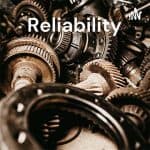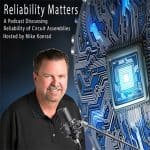
Reliability and Statistics
Abstract
Kirk and Fred discussing the use of statistics in reliability engineering, where they are useful and where their use may not be the most efficient way to find and fix the cause of failure.
ᐅ Play Episode
Your Reliability Engineering Professional Development Site

Kirk and Fred discussing the use of statistics in reliability engineering, where they are useful and where their use may not be the most efficient way to find and fix the cause of failure.
ᐅ Play Episode
by Akshay Athalye Leave a Comment

by Dianna Deeney Leave a Comment


As engineers, we need to write reports all the time.
Are ours getting returned by reviewers frequently?
Or are we not getting any feedback and are not sure when our report is ‘done’?
We explore the spirits of technical writing past, present, and future – they help us to write for ALL of our audiences. We explore how and why in the episode.
by Mike Konrad Leave a Comment

Historically, circuit assemblies are rigid devices. IoT (Internet of Things) has opened up the opportunity to embed electronics into a near limitless array of form factors. Some of these form factors require the electronic assembly to be flexible such as in wearable and medical applications.
To complicate matters, The metal conductors on the assembly are rigid, and not flexible or malleable. That may change with the adoption of liquid metals. We were all exposed to the concept of liquid metal in the 1991 film Terminator 2. Will science fiction become reality?
My guest today is Dr. Michael Dickey. Michael is currently the Camille and Henry Dreyfus Professor in the Department of Chemical & Biomolecular Engineering at NC State University.
Michael Dickey received a BS in Chemical Engineering from Georgia Institute of Technology and a PhD from the University of Texas. From 2006-2008 he was a post-doctoral fellow in the lab of Professor George Whitesides at Harvard University. Michael completed a sabbatical at Microsoft in 2016. Michael’s research interests include soft matter (liquid metals, gels and polymers) for soft and stretchable devices (electronics, energy harvesters, textiles, and soft robotics), and hopefully, for the sake of humanity, not liquid metal T1000 villains.
Dr. Michael Dickey’s Contact Information:
mddickey@ncsu.edu
Link to Michael Dickey’s TED-X Talk:
https://www.youtube.com/watch?v=lfUnK_rME8E

Kirk and Fred discussing the idea of listing of failure mechanisms and their different viewpoints on how we learn some of the common failure mechanisms
ᐅ Play Episode
by Dianna Deeney Leave a Comment

Dianna and Fred discussing single use product reliability. For products that are used once and then disposed or recycled, do we need to consider and plan for their reliability? The short answer: yes! They talk about the things to consider with single use products.
ᐅ Play Episode
by Michael Pfeifer, Ph.D., P.E. Leave a Comment

I discuss my education, my experience working in a semiconductor factory and as part of a product design group, and the many different product design and manufacturing activities I was involved in as a metals engineer.
by Dianna Deeney Leave a Comment

What are the gifts others bring to new product development?
It takes intentional actions and acknowledgement to understand how to bring design inputs into our designs from other people.
We consider project teams like a neighborhood and how this frame of mind can help our designs.
by Dianna Deeney Leave a Comment

Dianna and Fred discussing a listener question about understanding stresses and mechanism of failures of a new design.
ᐅ Play Episode

Kirk and Fred discussing how a good reliability development process is to identify the weaknesses to improve a product including a recent fence repair at Kirk’s house.
ᐅ Play Episode
by Dianna Deeney Leave a Comment

During product development, we’re consistently looking for ways to learn more about the product in order to make design decisions. Some of that comes from test.
What do we do when our test results are…surprising?
We talk about some next steps I typically take when tasked with surprises.

Kirk and Fred discussing the paths they took in Reliability Engineering, how our past experience shaped our view of the best methods for improving the reliability of systems, and how we learn new information on reliability issues.
ᐅ Play Episode
by Greg Hutchins Leave a Comment

Greg and Fred discussing why people have a hard time adjusting and pivoting in times of uncertainty, much like what we all experience today.
ᐅ Play Episode
by Michael Pfeifer, Ph.D., P.E. Leave a Comment

This episode is an introduction to the Metal Conversations podcast. Michael Pfeifer from Industrial Metallurgists, LLC introduces himself and gives a brief description of what the podcast series will be about.
Michael Pfeifer is a metallurgist and metals engineer. He works with design and manufacturing clients to help with component materials selection, manufacturing process development, supplier evaluation, failure analysis and root cause analysis.
He received a B.S. and M.S. in Metallurgical Engineering from University of Illinois and a Ph.D. in Materials Science and Engineering from Northwestern University. He is a Professional Engineer, licensed in Illinois.
He’s wrote a book – Materials Enabled Designs. It teaches how to select materials that optimize product performance, reliability, and cost.
For more information about Michael go to https://www.imetllc.com/about/
Industrial Metallurgists offer metallurgy and metals engineering consulting and training. The training is geared to design, manufacturing, and quality engineers. More information about Industrial Metallurgists’ services and training is at https://www.imetllc.com/
by Dianna Deeney Leave a Comment

We have a reliability target for our system. But we’re not meeting it.
To avoid this scenario, what is something we can do in early development?
When we’re figuring out our concept, we can better learn about our options. We can work with Reliability Engineers to understand what we know, the risk in what we don’t know, and to prioritize reliability of the modules to be able to meet the reliability of our whole system.
We talk about using reliability allocation to help us choose reliability goals for modules of our product design. And we talk about its limitations.